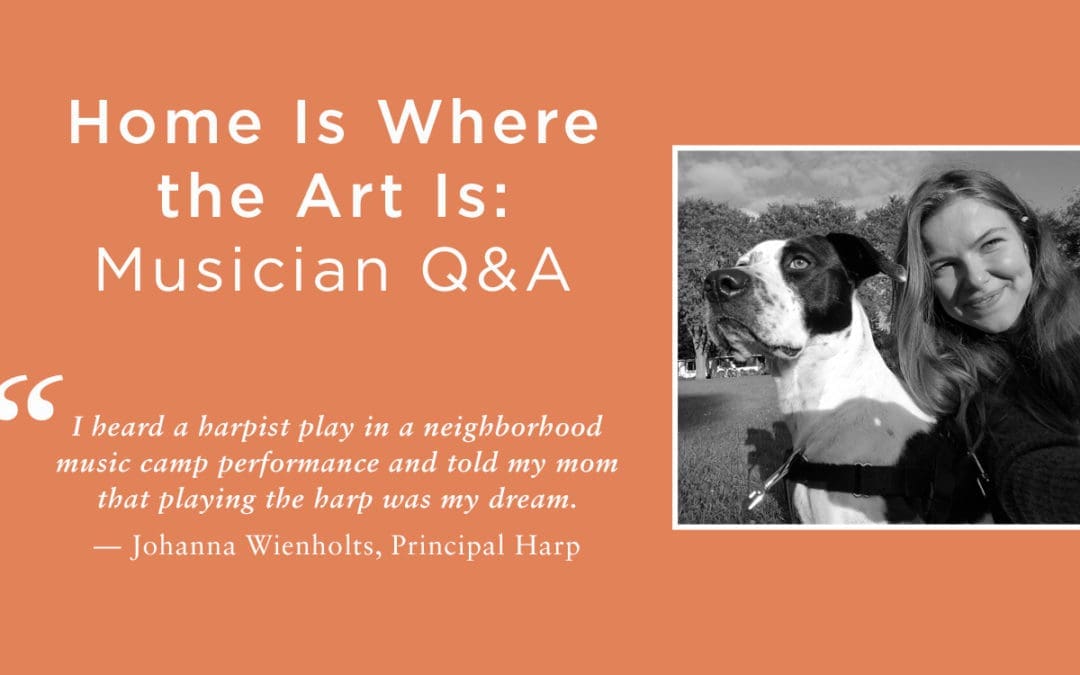Johanna Wienholts, Principal Harp, has been performing with the Madison Symphony Orchestra since 2017. Johanna’s chair has been endowed by an Anonymous Friend. This Q&A is part of our Home Is Where the Art Is series of artist stories featuring our musicians.
When did you first start playing your musical instrument?
I first started playing harp at five years old! Believe it or not, it is possible to learn this instrument at an extremely young age, but it was a much smaller harp than you see onstage at the Overture Center. I heard a harpist play in a neighborhood music camp performance and told my mom that playing the harp was my dream. She found a wonderful teacher for me and here I am!
What stories come to mind that led to your choice to make music a focus in your life?
When I was at Interlochen Arts Academy during my senior year of high school, my teacher Joan Holland and I were talking about college auditions and what I wanted to do after high school. I had been planning on declaring a major in something that wasn’t music related and minoring in harp. She thoughtfully responded that I should consider harp professionally, and suggested that if I didn’t, “the world would miss out on something.” A career in music hadn’t completely occurred to me, and it certainly never occurred to me that I might have a unique voice in the harp world. She encouraged me into a life in the arts and helped me to believe that it was possible.
Tell us about what happens during rehearsals from the point of view of your part and section in the orchestra?
Because I am a section of one (though Dan Lyons on piano often feels like a stand partner when we have interlocking parts), the most important things to determine in rehearsal are:
- When to come in! This is critical! Sometimes I am counting for entire movements and come in alone at the very end, and if I lose focus in rehearsals I won’t feel confident in my entrances during the performances.
- Balance. Different parts of the harp project in different ways. Often times the top of the harp in the higher register cuts through thick instrumentation while the low register on the harp doesn’t come through very much at all. Sometimes harp is purely there for color and other times the instrument carries thematic material that needs to be present. Only in rehearsal in the hall can we really determine how much to project and when.
What is unique about your instrument and preparing it for playing at a rehearsal or concert?
The pedals on the harp are one of the most unique things about the instrument. For those who don’t know, there are seven pedals at the bottom of the harp with three notches that are manipulated by the feet while we play. The pedals change pitch on the strings from flat to natural to sharp. When harpists change keys or play accidentals, our feet have to do the work. One of the first steps to prepare a part for a rehearsal is to go through and indicate in the music where all the pedal changes need to happen. During very difficult passages, the most treacherous thing is navigating the pedals, because if I miss one I will end up in a completely different key!
What are things you’re cooking, shows/movies you’re watching, and/or other hobbies you’ve developed during this time?
Right now I’ve been spending as much time outside in the beautiful spring weather as possible! I love taking my dog for long walks or jogs and listening to various podcasts (some of my favorites are Ear Hustle made inside San Quentin prison and Unlocking Us with Brené Brown). I’ve been cooking, gardening, and painting as well. My most recent project was a quilt I made with silk that I hand dyed with vegetable scraps!

